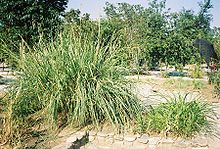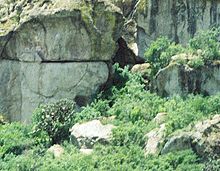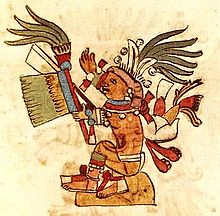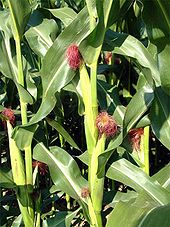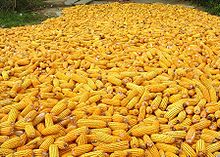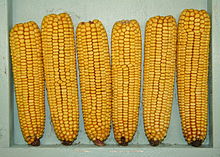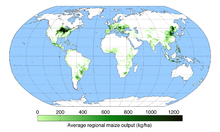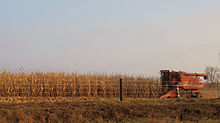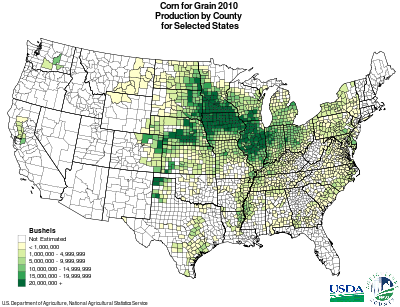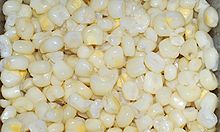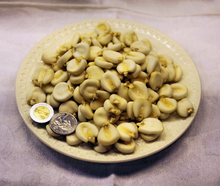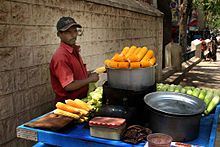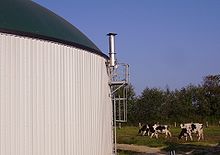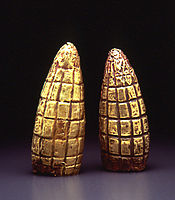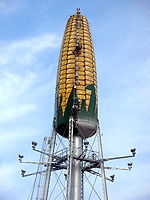
Maize
About this schools Wikipedia selection
This selection is made for schools by a children's charity read more. SOS Children is the world's largest charity giving orphaned and abandoned children the chance of family life.
| Maize | |
|---|---|
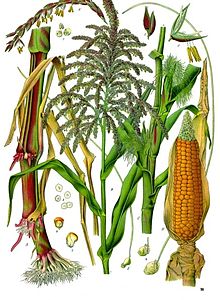 |
|
| Illustration depicting both male and female flowers of maize | |
| Scientific classification | |
| Kingdom: | Plantae |
| (unranked): | Angiosperms |
| (unranked): | Monocots |
| (unranked): | Commelinids |
| Order: | Poales |
| Family: | Poaceae |
| Subfamily: | Panicoideae |
| Tribe: | Andropogoneae |
| Genus: | Zea |
| Species: | Z. mays |
| Binomial name | |
| Zea mays L. |
|
Maize (pron.: / ˈ m eɪ z / MAYZ; Zea mays subsp. mays L, from Spanish: maíz after Taíno mahiz), known in some English-speaking countries as corn (meaning grain), is a large grain plant domesticated by indigenous peoples in Mesoamerica in prehistoric times. The leafy stalk produces ears which contain the grain, which are seeds called kernels. Maize kernels are used in cooking as a starch. The Olmec and Mayans cultivated it in numerous varieties throughout Mesoamerica, cooked, ground or processed through nixtamalization. Beginning about 2500 BC, the crop spread through much of the Americas. The region developed a trade network based on surplus and varieties of maize crops. After European contact with the Americas in the late 15th and early 16th centuries, explorers and traders carried maize back to Europe and introduced it to other countries. Maize spread to the rest of the world because of its ability to grow in diverse climates. Sugar-rich varieties called sweet corn are usually grown for human consumption, while field corn varieties are used for animal feed and as chemical feedstocks.
Maize is the most widely grown grain crop throughout the Americas, with 332 million metric tons grown annually in the United States alone. Approximately 40% of the crop — 130 million tons — is used for corn ethanol. Transgenic maize (genetically modified corn) made up 85% of the maize planted in the United States in 2009.
Words for maize
The word maize derives from the Spanish form of the indigenous Taíno word for the plant, maiz. It is known by other names around the world.
Corn outside Canada and the United States means any cereal crop, its meaning understood to vary geographically to refer to the local staple. In Canada and the United States, "corn" primarily means maize; this usage started as a shortening of "Indian corn". "Indian corn" primarily means maize (the staple grain of indigenous Americans), but can refer more specifically to multicolored " flint corn" used for decoration.
Outside Canada and the United States, the word corn often refers to maize in culinary contexts. The narrower meaning is usually indicated by some additional word, as in sweet corn, corn on the cob, popcorn, corn flakes, baby corn.
In Southern Africa, maize is commonly called mielie (Afrikaans) or mealie (English).
Maize is preferred in formal, scientific, and international usage because it refers specifically to this one grain, unlike corn, which has a complex variety of meanings that vary by context and geographic region. However, in bulk-trading, people use "corn" only to refer to maize. Maize is used by agricultural bodies and research institutes such as the FAO and CSIRO. National agricultural and industry associations often include the word maize in their name even in English-speaking countries where the local, informal word is something other than maize; for example, the Maize Association of Australia, the Indian Maize Development Association, the Kenya Maize Consortium and Maize Breeders Network, the National Maize Association of Nigeria, the Zimbabwe Seed Maize Association.
Structure and physiology
The maize plant is often 2.5 m (meters) (8 ft) in height, though some natural strains can grow 12 m (40 ft). The stem has the appearance of a bamboo cane and is commonly composed of 20 internodes of 18 cm (7 in) length. A leaf grows from each node, which is generally 9 cm (3.5 in) in width and 120 cm (4 ft) in length.
Ears develop above a few of the leaves in the midsection of the plant, between the stem and leaf sheath, elongating by ~ 3 mm/day, to a length of 18 cm (7 in) (60 cm/24 in being the maximum observed in the subspecies ). They are female inflorescences, tightly enveloped by several layers of ear leaves commonly called husks. Certain varieties of maize have been bred to produce many additional developed ears. These are the source of the " baby corn" used as a vegetable in Asian cuisine.
The apex of the stem ends in the tassel, an inflorescence of male flowers. When the tassel is mature and conditions are suitably warm and dry, anthers on the tassel dehisce and release pollen. Maize pollen is anemophilous (dispersed by wind), and because of its large settling velocity, most pollen falls within a few meters of the tassel.
Elongated stigmas, called silks, emerge from the whorl of husk leaves at the end of the ear. They are often pale yellow and 7 in (178 mm) in length, like tufts of hair in appearance. At the end of each is a carpel, which may develop into a "kernel" if fertilized by a pollen grain. The pericarp of the fruit is fused with the seed coat referred to as " caryopsis", typical of the grasses, and the entire kernel is often referred to as the "seed". The cob is close to a multiple fruit in structure, except that the individual fruits (the kernels) never fuse into a single mass. The grains are about the size of peas, and adhere in regular rows around a white, pithy substance, which forms the ear (maximum size of kernel in subspecies is reputedly 2.5 cm/1 in ). An ear commonly holds 600 kernels. They are of various colors: blackish, bluish-gray, purple, green, red, white and yellow. When ground into flour, maize yields more flour with much less bran than wheat does. It lacks the protein gluten of wheat and, therefore, makes baked goods with poor rising capability. A genetic variant that accumulates more sugar and less starch in the ear is consumed as a vegetable and is called sweet corn. Young ears can be consumed raw, with the cob and silk, but as the plant matures (usually during the summer months), the cob becomes tougher and the silk dries to inedibility. By the end of the growing season, the kernels dry out and become difficult to chew without cooking them tender first in boiling water.
Planting density affects multiple aspects of maize. Modern farming techniques in developed countries usually rely on dense planting, which produces one ear per stalk. Stands of silage maize are yet denser, and achieve a lower percentage of ears and more plant matter.
Maize is a facultative long-night plant and flowers in a certain number of growing degree days > 10 °C (50 °F) in the environment to which it is adapted. The magnitude of the influence that long nights have on the number of days that must pass before maize flowers is genetically prescribed and regulated by the phytochrome system. Photoperiodicity can be eccentric in tropical cultivars such that the long days characteristic of higher latitudes allow the plants to grow so tall that they do not have enough time to produce seed before being killed by frost. These attributes, however, may prove useful in using tropical maize for biofuels.
Immature maize shoots accumulate a powerful antibiotic substance, 2,4-dihydroxy-7-methoxy-1,4-benzoxazin-3-one ( DIMBOA). DIMBOA is a member of a group of hydroxamic acids (also known as benzoxazinoids) that serve as a natural defense against a wide range of pests, including insects, pathogenic fungi and bacteria. DIMBOA is also found in related grasses, particularly wheat. A maize mutant (bx) lacking DIMBOA is highly susceptible to attack by aphids and fungi. DIMBOA is also responsible for the relative resistance of immature maize to the European corn borer (family Crambidae). As maize matures, DIMBOA levels and resistance to the corn borer decline.
Because of its shallow roots, maize is susceptible to droughts, intolerant of nutrient-deficient soils, and prone to be uprooted by severe winds.
Genetics
Many forms of maize are used for food, sometimes classified as various subspecies related to the amount of starch each has:
- Flour corn — Zea mays var. amylacea
- Popcorn — Zea mays var. everta
- Dent corn — Zea mays var. indentata
- Flint corn — Zea mays var. indurata
- Sweet corn — Zea mays var. saccharata and Zea mays var. rugosa
- Waxy corn — Zea mays var. ceratina
- Amylomaize — Zea mays
- Pod corn — Zea mays var. tunicata Larrañaga ex A. St. Hil.
- Striped maize — Zea mays var. japonica
This system has been replaced (though not entirely displaced) over the last 60 years by multivariable classifications based on ever more data. Agronomic data were supplemented by botanical traits for a robust initial classification, then genetic, cytological, protein and DNA evidence was added. Now, the categories are forms (little used), races, racial complexes, and recently branches.
Maize is a diploid with 20 chromosomes (n=10). The combined length of the chromosomes is 1500 cM. Some of the maize chromosomes have what are known as "chromosomal knobs": highly repetitive heterochromatic domains that stain darkly. Individual knobs are polymorphic among strains of both maize and teosinte.
Barbara McClintock used these knob markers to validate her transposon theory of "jumping genes", for which she won the 1983 Nobel Prize in Physiology or Medicine. Maize is still an important model organism for genetics and developmental biology today.
The Maize Genetics Cooperation Stock Centre, funded by the USDA Agricultural Research Service and located in the Department of Crop Sciences at the University of Illinois at Urbana-Champaign, is a stock centre of maize mutants. The total collection has nearly 80,000 samples. The bulk of the collection consists of several hundred named genes, plus additional gene combinations and other heritable variants. There are about 1000 chromosomal aberrations (e.g., translocations and inversions) and stocks with abnormal chromosome numbers (e.g., tetraploids). Genetic data describing the maize mutant stocks as well as myriad other data about maize genetics can be accessed at MaizeGDB, the Maize Genetics and Genomics Database.
In 2005, the U.S. National Science Foundation (NSF), Department of Agriculture ( USDA) and the Department of Energy (DOE) formed a consortium to sequence the B73 maize genome. The resulting DNA sequence data was deposited immediately into GenBank, a public repository for genome-sequence data. Sequences and genome annotations have also been made available throughout the project's lifetime at the project's official site, MaizeSequence.org.
Primary sequencing of the maize genome was completed in 2008. On November 20, 2009, the consortium published results of its sequencing effort in Science. The genome, 85% of which is composed of transposons, was found to contain 32,540 genes (By comparison, the human genome contains about 2.9 billion bases and 26,000 genes). Much of the maize genome has been duplicated and reshuffled by helitrons - group of rolling circle transposons.
Breeding
Maize breeding in prehistory resulted in large plants producing large ears. Modern breeding began with individuals who selected highly productive varieties in their fields and then sold seed to other farmers. James L. Reid was one of the earliest and most successful developing Reid's Yellow Dent in the 1860s. These early efforts were based on mass selection. Later breeding efforts included ear to row selection, (C. G. Hopkins ca. 1896), hybrids made from selected inbred lines (G. H. Shull, 1909), and the highly successful double cross hybrids using 4 inbred lines (D. F. Jones ca. 1918, 1922). University supported breeding programs were especially important in developing and introducing modern hybrids. (Ref Jugenheimer Hybrid Maize Breeding and Seed Production pub. 1958) by the 1930s, companies such as Pioneer devoted to production of hybrid maize had begun to influence long term development. Internationally important seed banks such as CIMMYT and the U.S. bank at Maize Genetics Cooperation Stock Centre University of Illinois at Urbana-Champaign maintain germplasm important for future crop development.
Genetic modification
Genetically modified (GM) maize is one of the 25 GM crops grown commercially in 2011. Grown since 1997 in the United States and Canada, 86% of the US maize crop was genetically modified in 2010 and 32% of the worldwide maize crop was GM in 2011. As of 2011, Herbicide-tolerant maize varieties are grown in Argentina, Australia, Brazil, Canada, China, Colombia, El Salvador, EU, Honduras, Japan, Korea, Malaysia, Mexico, New Zealand, Philippines, the Russian Federation, Singapore, South Africa, Taiwan, Thailand, and USA, and insect-resistant corn is grown in Argentina, Australia, Brazil, Canada, Chile, China, Colombia, Czech Republic, Egypt, EU, Honduras, Japan, Korea, Malaysia, Mexico, Netherlands, New Zealand, Philippines, Romania, Russian Federation, South Africa, Switzerland, Taiwan, USA, and Uruguay.
Origin
Maize is the domesticated variant of teosinte. The two plants have dissimilar appearance, maize having a single tall stalk with multiple leaves and teosinte being a short, bushy plant. The difference between the two is largely controlled by differences in just two genes.
Several theories had been proposed about the specific origin of maize in Mesoamerica:
- It is a direct domestication of a Mexican annual teosinte, Zea mays ssp. parviglumis, native to the Balsas River valley in south-eastern Mexico, with up to 12% of its genetic material obtained from Zea mays ssp. mexicana through introgression.
- It has been derived from hybridization between a small domesticated maize (a slightly changed form of a wild maize) and a teosinte of section Luxuriantes, either Z. luxurians or Z. diploperennis.
- It has undergone two or more domestications either of a wild maize or of a teosinte. (The term "teosinte" describes all species and subspecies in the genus Zea, excluding Zea mays ssp. mays.)
- It has evolved from a hybridization of Z. diploperennis by Tripsacum dactyloides.
In the late 1930s, Paul Mangelsdorf suggested that domesticated maize was the result of a hybridization event between an unknown wild maize and a species of Tripsacum, a related genus. This theory about the origin of maize has been refuted by modern genetic testing, which refutes Mangelsdorf's model and the fourth listed above.
The teosinte origin theory was proposed by the Russian botanist Nikolai Ivanovich Vavilov in 1931 and the later American Nobel Prize-winner George Beadle in 1932. It is supported experimentally and by recent studies of the plants' genomes. Teosinte and maize are able to cross-breed and produce fertile offspring. A number of questions remain concerning the species, among them:
- how the immense diversity of the species of sect. Zea originated,
- how the tiny archaeological specimens of 3500–2700 BC could have been selected from a teosinte, and
- how domestication could have proceeded without leaving remains of teosinte or maize with teosintoid traits earlier than the earliest known until recently, dating from ca. 1100 BC.
The domestication of maize is of particular interest to researchers — archaeologists, geneticists, ethnobotanists, geographers, etc. The process is thought by some to have started 7,500 to 12,000 years ago. Research from the 1950s to 1970s originally focused on the hypothesis that maize domestication occurred in the highlands between the states of Oaxaca and Jalisco, because the oldest archaeological remains of maize known at the time were found there. Genetic studies led by John Doebley identified Zea mays ssp. parviglumis, native to the Balsas River valley in Mexico's southwestern highlands, and also known as Balsas teosinte, as being the crop wild relative teosinte genetically most similar to modern maize. However, archaeobotanical studies published in 2009 now point to the lowlands of the Balsas River valley, where stone milling tools with maize residue have been found in a 8,700-years old layer of deposits. A primitive corn was being grown in southern Mexico, Central America, and northern South America 7,000 years ago. Archaeological remains of early maize ears, found at Guila Naquitz Cave in the Oaxaca Valley, date back roughly 6,250 years; the oldest ears from caves near Tehuacan, Puebla, date ca. 3,450 BC. Little change occurred in ear form until ca. 1100 BC when great changes appeared in ears from Mexican caves: maize diversity rapidly increased and archaeological teosinte was first deposited.
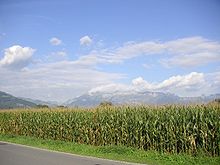
Perhaps as early as 2500 BC, maize began to spread widely and rapidly. It was first cultivated in what is now the United States, at several sites in New Mexico and Arizona, about 2100 BC. As it was introduced to new cultures, new uses were developed and new varieties selected to better serve in those preparations. Maize was the staple food, or a major staple (along with squash, Andean region potato, quinoa, beans, and amaranth), of most pre-Columbian North American, Mesoamerican, South American, and Caribbean cultures. The Mesoamerican civilization was strengthened upon the field crop of maize, through harvesting it, its religious and spiritual importance and how it impacted their diet. Maize formed the Mesoamerican people's identity. During the first millennium AD, maize cultivation spread from Mexico into the U.S. Southwest and during the following millennium into the U.S. Northeast and southeastern Canada, transforming the landscape as Native Americans cleared large forest and grassland areas for the new crop.
It is unknown what precipitated its domestication, because the edible portion of the wild variety is too small and hard to obtain to be eaten directly, as each kernel is enclosed in a very hard bivalve shell. However, George Beadle demonstrated that the kernels of teosinte are readily "popped" for human consumption, like modern popcorn. Some have argued it would have taken too many generations of selective breeding to produce large, compressed ears for efficient cultivation. However, studies of the hybrids readily made by intercrossing teosinte and modern maize suggest this objection is not well founded.
In 2005, research by the USDA Forest Service suggested that the rise in maize cultivation 500 to 1,000 years ago in what is now the southeastern United States corresponded with a decline of freshwater mussels, which are very sensitive to environmental changes.
Production
Methods
Because it is cold-intolerant, in the temperate zones maize must be planted in the spring. Its root system is generally shallow, so the plant is dependent on soil moisture. As a C4 plant (a plant that uses C4 carbon fixation), maize is a considerably more water-efficient crop than C3 plants (plants that use C3 carbon fixation) like the small grains, alfalfa and soybeans. Maize is most sensitive to drought at the time of silk emergence, when the flowers are ready for pollination. In the United States, a good harvest was traditionally predicted if the maize were "knee-high by the Fourth of July", although modern hybrids generally exceed this growth rate. Maize used for silage is harvested while the plant is green and the fruit immature. Sweet corn is harvested in the "milk stage", after pollination but before starch has formed, between late summer and early to mid-autumn. Field maize is left in the field very late in the autumn to thoroughly dry the grain, and may, in fact, sometimes not be harvested until winter or even early spring. The importance of sufficient soil moisture is shown in many parts of Africa, where periodic drought regularly causes maize crop failure and consequent famine. Although it is grown mainly in wet, hot climates, it has been said to thrive in cold, hot, dry or wet conditions, meaning that it is an extremely versatile crop.
Maize was planted by the Native Americans in hills, in a complex system known to some as the Three Sisters. Maize provided support for beans, and the beans provided nitrogen derived from nitrogen-fixing rhizobia bacteria which live on the roots of beans and other legumes; and squashes provided ground cover to stop weeds and inhibit evaporation by providing shade over the soil. This method was replaced by single species hill planting where each hill 60–120 cm (2.0–3.9 ft) apart was planted with three or four seeds, a method still used by home gardeners. A later technique was "checked maize", where hills were placed 40 inches (1.0 metre) apart in each direction, allowing cultivators to run through the field in two directions. In more arid lands, this was altered and seeds were planted in the bottom of 10–12 cm (3.9–4.7 in) deep furrows to collect water. Modern technique plants maize in rows which allows for cultivation while the plant is young, although the hill technique is still used in the maize fields of some Native American reservations.
In North America, fields are often planted in a two- crop rotation with a nitrogen-fixing crop, often alfalfa in cooler climates and soybeans in regions with longer summers. Sometimes a third crop, winter wheat, is added to the rotation.
Many of the maize varieties grown in the United States and Canada are hybrids. Often the varieties have been genetically modified to tolerate glyphosate or to provide protection against natural pests. Glyphosate (trade name Roundup) is an herbicide which kills all plants except those with genetic tolerance. This genetic tolerance is very rarely found in nature.
In midwestern United States, low-till or no-till farming techniques are usually used. In low-till, fields are covered once, maybe twice, with a tillage implement either ahead of crop planting or after the previous harvest. The fields are planted and fertilized. Weeds are controlled through the use of herbicides, and no cultivation tillage is done during the growing season. This technique reduces moisture evaporation from the soil, and thus provides more moisture for the crop. The technologies mentioned in the previous paragraph enable low-till and no-till farming. Weeds compete with the crop for moisture and nutrients, making them undesirable.
Before World War II, most maize in North America was harvested by hand. This involves a large numbers of workers and associated social events (husking or shucking bees). Some one- and two-row mechanical pickers were in use, but the maize combine was not adopted until after the War. By hand or mechanical picker, the entire ear is harvested, which then requires a separate operation of a maize sheller to remove the kernels from the ear. Whole ears of maize were often stored in corn cribs, and these whole ears are a sufficient form for some livestock feeding use. Few modern farms store maize in this manner. Most harvest the grain from the field and store it in bins. The combine with a maize head (with points and snap rolls instead of a reel) does not cut the stalk; it simply pulls the stalk down. The stalk continues downward and is crumpled in to a mangled pile on the ground. The ear of maize is too large to pass between slots in a plate as the snap rolls pull the stalk away, leaving only the ear and husk to enter the machinery. The combine separates out the husk and the cob, keeping only the kernels.
Quantity
Maize is widely cultivated throughout the world, and a greater weight of maize is produced each year than any other grain. The United States produces 40% of the world's harvest; other top producing countries include China, Brazil, Mexico, Indonesia, India, France and Argentina. Worldwide production was 817 million tonnes in 2009—more than rice (678 million tonnes) or wheat (682 million tonnes). In 2009, over 159 million hectares (390 million acres) of maize were planted worldwide, with a yield of over 5 tonnes/hectare (80 bu/acre). Production can be significantly higher in certain regions of the world; 2009 forecasts for production in Iowa were 11614 kg/ha (185 bu/acre). There is conflicting evidence to support the hypothesis that maize yield potential has increased over the past few decades. This suggests that changes in yield potential are associated with leaf angle, lodging resistance, tolerance of high plant density, disease/pest tolerance, and other agronomic traits rather than increase of yield potential per individual plant.
| Top ten maize producers in 2009 | ||||
|---|---|---|---|---|
| Country | Production ( tonnes) | Note | ||
| 333,010,910 | ||||
| 163,118,097 | ||||
| 51,232,447 | ||||
| 20,202,600 | ||||
| 17,629,740 | ||||
| 17,300,000 | ||||
| 15,299,900 | ||||
| 13,121,380 | ||||
| 12,050,000 | ||||
| 10,486,300 | ||||
| World | 817,110,509 | [A] | ||
| No symbol = official figure, A = Aggregate (may include official, semiofficial or estimates). | ||||
United States
In 2010, the maize planted area for all purposes in the US was estimated at 35 million hectares (87.9 million acres), following an increasing trend since 2008. About 14% of the harvested corn area is irrigated. In 2011, corn production went down around 1% to about 13 billion bushels. The average yield in the U.S. was estimated to be 148.1 bushels per acre, making 2011 the lowest average yield since 2005. Corn production in the U.S. is expected to dramatically decline in 2012 due to widespread extreme to exceptional drought. 2012's average yield is estimated to be only 120 bushels per acre.
Pests
Insects
- Common armyworm ( Pseudaletia unipuncta)
- Common earwig ( Forficula auricularia)
- Corn delphacid ( Peregrinus maidis)
- Corn leaf aphid ( Rhopalosiphum maidis)
- Corn silkfly ( Euxesta stigmatis)
- European corn borer ( Ostrinia nubilalis) (ECB)
- Fall armyworm ( Spodoptera frugiperda)
- Corn earworm ( Helicoverpa zea)
- Lesser cornstalk borer ( Elasmopalpus lignosellus)
- Maize weevil ( Sitophilus zeamais)
- Southwestern corn borer ( Diatraea grandiosella)
- Stalk borer ( Papaipema nebris)
- Western corn rootworm ( Diabrotica virgifera virgifera LeConte)
The susceptibility of maize to the European corn borer, and the resulting large crop losses, led to the development of transgenics expressing the Bacillus thuringiensis toxin. "Bt maize" is widely grown in the United States and has been approved for release in Europe.
Diseases
- Common Rust caused by Puccinia sorghi
- Corn smut or common smut (Ustilago maydis): a fungal disease, known in Mexico as huitlacoche, which is prized by some as a gourmet delicacy in itself
- Northern leaf blight
- Southern leaf blight
- Maize dwarf mosaic virus
- Maize streak virus
- Stewart's wilt (Pantoea stewartii)
- Common rust (Puccinia sorghi)
- Goss's wilt (Clavibacter michiganese)
- Grey leaf spot
- Mal de Río Cuarto virus (MRCV)
- Stalk rot
- Ear rot
Uses
Human food
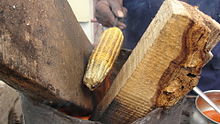
Maize and cornmeal (ground dried maize) constitute a staple food in many regions of the world.
Maize is central to Mexican food. Virtually every dish in Mexican cuisine uses maize. On form of grain or cornmeal, maize is the main ingredient of tortillas, tamales, pozole, atole and all the dishes based on them, like tacos, quesadillas, chilaquiles, enchiladas, tostadas and many more. In Mexico even a fungus of maize, known as huitlacoche is considered a delicacy.
Introduced into Africa by the Portuguese in the 16th century, maize has become Africa's most important staple food crop. Maize meal is made into a thick porridge in many cultures: from the polenta of Italy, the angu of Brazil, the mămăligă of Romania, to cornmeal mush in the U.S. (and hominy grits in the South) or the food called mealie pap in South Africa and sadza, nshima and ugali in other parts of Africa. Maize meal is also used as a replacement for wheat flour, to make cornbread and other baked products. Masa (cornmeal treated with limewater) is the main ingredient for tortillas, atole and many other dishes of Central American food.
Popcorn consists of kernels of certain varieties that explode when heated, forming fluffy pieces that are eaten as a snack. Roasted dried maize ears with semihardened kernels, coated with a seasoning mixture of fried chopped spring onions with salt added to the oil, is a popular snack food in Vietnam. Cancha, which are roasted maize chulpe kernels, are a very popular snack food in Peru, and also appears in traditional Peruvian ceviche. An unleavened bread called makki di roti is a popular bread eaten in the Punjab region of India and Pakistan.
Chicha and chicha morada (purple chicha) are drinks typically made from particular types of maize. The first one is fermented and alcoholic, the second is a soft drink commonly drunk in Peru. Corn flakes are a common breakfast cereal in North America and the United Kingdom, and found in many other countries all over the world.
Maize can also be prepared as hominy, in which the kernels are soaked with lye in a process called nixtamalization; or grits, which are coarsely ground hominy. These are commonly eaten in the Southeastern United States, foods handed down from Native Americans, who called the dish sagamite.
The Brazilian dessert canjica is made by boiling maize kernels in sweetened milk. Maize can also be harvested and consumed in the unripe state, when the kernels are fully grown but still soft. Unripe maize must usually be cooked to become palatable; this may be done by simply boiling or roasting the whole ears and eating the kernels right off the cob. Sweet corn, a genetic variety that is high in sugars and low in starch, is usually consumed in the unripe state. Such corn on the cob is a common dish in the United States, Canada, United Kingdom, Cyprus, some parts of South America, and the Balkans, but virtually unheard of in some European countries. Corn on the cob was hawked on the streets of early 19th-century New York City by poor, barefoot "Hot Corn Girls", who were thus the precursors of hot dog carts, churro wagons, and fruit stands seen on the streets of big cities today. The cooked, unripe kernels may also be shaved off the cob and served as a vegetable in side dishes, salads, garnishes, etc. Alternatively, the raw unripe kernels may also be grated off the cobs and processed into a variety of cooked dishes, such as maize purée, tamales, pamonhas, curau, cakes, ice creams, etc.
| Nutritional value per 100 g (3.5 oz) | |
|---|---|
| Energy | 360 kJ (86 kcal) |
| Carbohydrates | 19.02 g |
| - Sugars | 3.22 g |
| - Dietary fibre | 2.7 g |
| Fat | 1.18 g |
| Protein | 3.22 g |
| - Tryptophan | 0.023 g |
| - Threonine | 0.129 g |
| - Isoleucine | 0.129 g |
| - Leucine | 0.348 g |
| - Lysine | 0.137 g |
| - Methionine | 0.067 g |
| - Cystine | 0.026 g |
| - Phenylalanine | 0.150 g |
| - Tyrosine | 0.123 g |
| - Valine | 0.185 g |
| - Arginine | 0.131 g |
| - Histidine | 0.089 g |
| - Alanine | 0.295 g |
| - Aspartic acid | 0.244 g |
| - Glutamic acid | 0.636 g |
| - Glycine | 0.127 g |
| - Proline | 0.292 g |
| - Serine | 0.153 g |
| Water | 75.96 g |
| Vitamin A equiv. | 9 μg (1%) |
| - lutein and zeaxanthin | 644 μg |
| Thiamine (vit. B1) | 0.200 mg (17%) |
| Niacin (vit. B3) | 1.700 mg (11%) |
| Vitamin B6 | 0.093 mg (7%) |
| Folate (vit. B9) | 46 μg (12%) |
| Vitamin C | 6.8 mg (8%) |
| Iron | 0.52 mg (4%) |
| Magnesium | 37 mg (10%) |
| Potassium | 270 mg (6%) |
| One ear of medium size (6-3/4" to 7-1/2" long) maize has 90 grams of seeds Percentages are relative to US recommendations for adults. Source: USDA Nutrient Database |
|
Maize is a major source of starch. Cornstarch (maize flour) is a major ingredient in home cooking and in many industrialized food products. Maize is also a major source of cooking oil (corn oil) and of maize gluten. Maize starch can be hydrolyzed and enzymatically treated to produce syrups, particularly high-fructose corn syrup, a sweetener; and also fermented and distilled to produce grain alcohol. Grain alcohol from maize is traditionally the source of Bourbon whiskey. Maize is sometimes used as the starch source for beer. Within the United States, the usage of maize for human consumption constitutes about 1/40th of the amount of grown in the country. In the United States and Canada, maize is mostly grown to feed for livestock, as forage, silage (made by fermentation of chopped green cornstalks), or grain. Maize meal is also a significant ingredient of some commercial animal food products, such as dog food.
Maize is also used as a fish bait, called "dough balls". It is particularly popular in Europe for coarse fishing.
Alternative medicine
Stigmas from female maize flowers, popularly called corn silk, are sold as herbal supplements.
Chemicals
Starch from maize can also be made into plastics, fabrics, adhesives, and many other chemical products.
The corn steep liquor, a plentiful watery byproduct of maize wet milling process, is widely used in the biochemical industry and research as a culture medium to grow many kinds of microorganisms.
Bio-fuel
"Feed maize" is being used increasingly for heating; specialized corn stoves (similar to wood stoves) are available and use either feed maize or wood pellets to generate heat. Maize cobs are also used as a biomass fuel source. Maize is relatively cheap and home-heating furnaces have been developed which use maize kernels as a fuel. They feature a large hopper that feeds the uniformly sized maize kernels (or wood pellets or cherry pits) into the fire.
Maize is increasingly used as a feedstock for the production of ethanol fuel. Ethanol is mixed with gasoline to decrease the amount of pollutants emitted when used to fuel motor vehicles. High fuel prices in mid-2007 led to higher demand for ethanol, which in turn lead to higher prices paid to farmers for maize. This led to the 2007 harvest being one of the most profitable maize crops in modern history for farmers. Because of the relationship between fuel and maize, prices paid for the crop now tend to track the price of oil.
The price of food is affected to a certain degree by the use of maize for biofuel production. The cost of transportation, production, and marketing are a large portion (80%) of the price of food in the United States. Higher energy costs affect these costs, especially transportation. The increase in food prices the consumer has been seeing is mainly due to the higher energy cost. The effect of biofuel production on other food crop prices is indirect. Use of maize for biofuel production increases the demand, and therefore price of maize. This, in turn, results in farm acreage being diverted from other food crops to maize production. This reduces the supply of the other food crops and increases their prices.
Maize is widely used in Germany as a feedstock for biogas plants. Here the maize is harvested, shredded then placed in silage clamps from which it is fed into the biogas plants. This process makes use of the whole plant rather than simply using the kernels as in the production of fuel ethanol.
A biomass gasification power plant in Strem near Güssing, Burgenland, Austria, began in 2005. Research is being done to make diesel out of the biogas by the Fischer Tropsch method.
Increasingly, ethanol is being used at low concentrations (10% or less) as an additive in gasoline ( gasohol) for motor fuels to increase the octane rating, lower pollutants, and reduce petroleum use (what is nowadays also known as "biofuels" and has been generating an intense debate regarding the human beings' necessity of new sources of energy, on the one hand, and the need to maintain, in regions such as Latin America, the food habits and culture which has been the essence of civilizations such as the one originated in Mesoamerica; the entry, January 2008, of maize among the commercial agreements of NAFTA has increased this debate, considering the bad labor conditions of workers in the fields, and mainly the fact that NAFTA "opened the doors to the import of maize from the United States, where the farmers who grow it receive multimillion dollar subsidies and other government supports. (...) According to OXFAM UK, after NAFTA went into effect, the price of maize in Mexico fell 70% between 1994 and 2001. The number of farm jobs dropped as well: from 8.1 million in 1993 to 6.8 million in 2002. Many of those who found themselves without work were small-scale maize growers."). However, introduction in the northern latitudes of the U.S. of tropical maize for biofuels, and not for human or animal consumption, may potentially alleviate this.
As a result of the U.S. federal government announcing its production target of 35 billion US gallons (130,000,000 m3) of biofuels by 2017, ethanol production will grow to 7 billion US gallons (26,000,000 m3) by 2010, up from 4.5 billion in 2006, boosting ethanol's share of maize demand in the U.S. from 22.6 percent to 36.1 percent.
Ornamental and other uses
Some forms of the plant are occasionally grown for ornamental use in the garden. For this purpose, variegated and colored leaf forms as well as those with colorful ears are used.
Corncobs can be hollowed out and treated to make inexpensive smoking pipes, first manufactured in the United States in 1869.
An unusual use for maize is to create a " corn maze" (or "maize maze") as a tourist attraction. The idea of a maize maze was introduced by the American Maze Company who created a maze in Pennsylvania in 1993. Traditional mazes are most commonly grown using yew hedges, but these take several years to mature. The rapid growth of a field of maize allows a maze to be laid out using GPS at the start of a growing season and for the maize to grow tall enough to obstruct a visitor's line of sight by the start of the summer. In Canada and the U.S., these are popular in many farming communities.
Maize kernels can be used in place of sand in a sandboxlike enclosure for children's play.
Additionally, feed corn is sometimes used by hunters to bait animals such as deer or wild hogs.
Fodder
Maize makes a greater quantity of epigeous mass than other cereal plants, so can be used for fodder. Digestibility and palatability are higher when ensiled and fermented, rather than dried.
Commodity
Maize is bought and sold by investors and price speculators as a tradable commodity using corn futures contracts. These "futures" are traded on the Chicago Board of Trade (CBOT) under ticker symbol C. They are delivered every year in March, May, July, September, and December.
U.S. usage breakdown
The breakdown of usage of the 12.1 billion bushel 2008 U.S. maize crop was as follows, according to the World Agricultural Supply and Demand Estimates Report by the USDA.
- 5,250 million bu. - livestock feed
- 3,650 million bu. - ethanol production
- 1,850 million bu. - exports
- 943 million bu. - production of starch, corn oil, sweeteners ( HFCS, etc.)
- 327 million bu. - human consumption - grits, corn flour, corn meal, beverage alcohol
Comparison to other staple foods
The following table shows the nutrient content of maize and major staple foods in a raw harvested form. Raw forms are not edible and cannot be digested. These must be sprouted, or prepared and cooked for human consumption. In sprouted or cooked form, the relative nutritional and anti-nutritional contents of each of these staples are different from that of raw form of these staples reported in the table below.
| STAPLE: | Maize / Corn | Rice | Wheat | Potato | Cassava | Soybean (Green) | Sweet potato | Sorghum | Yam | Plantain |
|---|---|---|---|---|---|---|---|---|---|---|
| Component (per 100g portion) | Amount | Amount | Amount | Amount | Amount | Amount | Amount | Amount | Amount | Amount |
| Water (g) | 76 | 12 | 11 | 79 | 60 | 68 | 77 | 9 | 70 | 65 |
| Energy (kJ) | 360 | 1528 | 1419 | 322 | 670 | 615 | 360 | 1419 | 494 | 511 |
| Protein (g) | 3.2 | 7.1 | 13.7 | 2.0 | 1.4 | 13.0 | 1.6 | 11.3 | 1.5 | 1.3 |
| Fat (g) | 1.18 | 0.66 | 2.47 | 0.09 | 0.28 | 6.8 | 0.05 | 3.3 | 0.17 | 0.37 |
| Carbohydrates (g) | 19 | 80 | 71 | 17 | 38 | 11 | 20 | 75 | 28 | 32 |
| Fibre (g) | 2.7 | 1.3 | 10.7 | 2.2 | 1.8 | 4.2 | 3 | 6.3 | 4.1 | 2.3 |
| Sugar (g) | 3.22 | 0.12 | 0 | 0.78 | 1.7 | 0 | 4.18 | 0 | 0.5 | 15 |
| Calcium (mg) | 2 | 28 | 34 | 12 | 16 | 197 | 30 | 28 | 17 | 3 |
| Iron (mg) | 0.52 | 4.31 | 3.52 | 0.78 | 0.27 | 3.55 | 0.61 | 4.4 | 0.54 | 0.6 |
| Magnesium (mg) | 37 | 25 | 144 | 23 | 21 | 65 | 25 | 0 | 21 | 37 |
| Phosphorus (mg) | 89 | 115 | 508 | 57 | 27 | 194 | 47 | 287 | 55 | 34 |
| Potassium (mg) | 270 | 115 | 431 | 421 | 271 | 620 | 337 | 350 | 816 | 499 |
| Sodium (mg) | 15 | 5 | 2 | 6 | 14 | 15 | 55 | 6 | 9 | 4 |
| Zinc (mg) | 0.45 | 1.09 | 4.16 | 0.29 | 0.34 | 0.99 | 0.3 | 0 | 0.24 | 0.14 |
| Copper (mg) | 0.05 | 0.22 | 0.55 | 0.11 | 0.10 | 0.13 | 0.15 | - | 0.18 | 0.08 |
| Manganese (mg) | 0.16 | 1.09 | 3.01 | 0.15 | 0.38 | 0.55 | 0.26 | - | 0.40 | - |
| Selenium (mcg) | 0.6 | 15.1 | 89.4 | 0.3 | 0.7 | 1.5 | 0.6 | 0 | 0.7 | 1.5 |
| Vitamin C (mg) | 6.8 | 0 | 0 | 19.7 | 20.6 | 29 | 2.4 | 0 | 17.1 | 18.4 |
| Thiamin (mg) | 0.20 | 0.58 | 0.42 | 0.08 | 0.09 | 0.44 | 0.08 | 0.24 | 0.11 | 0.05 |
| Riboflavin (mg) | 0.06 | 0.05 | 0.12 | 0.03 | 0.05 | 0.18 | 0.06 | 0.14 | 0.03 | 0.05 |
| Niacin (mg) | 1.70 | 4.19 | 6.74 | 1.05 | 0.85 | 1.65 | 0.56 | 2.93 | 0.55 | 0.69 |
| Pantothenic acid (mg) | 0.76 | 1.01 | 0.94 | 0.30 | 0.11 | 0.15 | 0.80 | - | 0.31 | 0.26 |
| Vitamin B6 (mg) | 0.06 | 0.16 | 0.42 | 0.30 | 0.09 | 0.07 | 0.21 | - | 0.29 | 0.30 |
| Folate Total (mcg) | 46 | 231 | 43 | 16 | 27 | 165 | 11 | 0 | 23 | 22 |
| Vitamin A (IU) | 208 | 0 | 0 | 2 | 13 | 180 | 14187 | 0 | 138 | 1127 |
| Vitamin E, alpha-tocopherol (mg) | 0.07 | 0.11 | 0 | 0.01 | 0.19 | 0 | 0.26 | 0 | 0.39 | 0.14 |
| Vitamin K (mcg) | 0.3 | 0.1 | 0 | 1.9 | 1.9 | 0 | 1.8 | 0 | 2.6 | 0.7 |
| Beta-carotene (mcg) | 52 | 0 | 0 | 1 | 8 | 0 | 8509 | 0 | 83 | 457 |
| Lutein+ zeazanthin (mcg) | 764 | 0 | 0 | 8 | 0 | 0 | 0 | 0 | 0 | 30 |
| Saturated fatty acids (g) | 0.18 | 0.18 | 0.45 | 0.03 | 0.07 | 0.79 | 0.02 | 0.46 | 0.04 | 0.14 |
| Monounsaturated fatty acids (g) | 0.35 | 0.21 | 0.34 | 0.00 | 0.08 | 1.28 | 0.00 | 0.99 | 0.01 | 0.03 |
| Polyunsaturated fatty acids (g) | 0.56 | 0.18 | 0.98 | 0.04 | 0.05 | 3.20 | 0.01 | 1.37 | 0.08 | 0.07 |
| A corn, sweet, yellow, raw | B rice, white, long-grain, regular, raw | ||||||||
| C wheat, durum | D potato, flesh and skin, raw | ||||||||
| E cassava, raw | F soybeans, green, raw | ||||||||
| G sweet potato, raw, unprepared | H sorghum, raw | ||||||||
| Y yam, raw | Z plantains, raw |
Hazards
Pellagra
When maize was first introduced into farming systems other than those used by traditional native-American peoples, it was generally welcomed with enthusiasm for its productivity. However, a widespread problem of malnutrition soon arose wherever maize was introduced as a staple food. This was a mystery, since these types of malnutrition were not normally seen among the indigenous Americans, for whom maize was the principal staple food.
It was eventually discovered that the indigenous Americans had learned to soak maize in alkali-water—made with ashes and lime ( calcium oxide) by Mesoamericans and North Americans—which liberates the B-vitamin niacin, the lack of which was the underlying cause of the condition known as pellagra. This alkali process is known by its Nahuatl (Aztec)-derived name: nixtamalization. Besides the lack of niacin, pellagra was also characterized by protein deficiency, a result of the inherent lack of two key amino acids in pre-modern maize, lysine and tryptophan. Nixtamalisation was also found to increase the availability of lysine and tryptophan to some extent, but more importantly, the indigenous Americans had also learned to balance their consumption of maize with beans and other protein sources such as amaranth and chia, as well as meat and fish, to acquire the complete range of amino acids for normal protein synthesis.
Maize was introduced into the diet of nonindigenous Americans without the necessary cultural knowledge acquired over thousands of years in the Americas. In the late 19th century, pellagra reached epidemic proportions in parts of the southern U.S., as medical researchers debated two theories for its origin: the deficiency theory (which was eventually shown to be true) said that pellagra was due to a deficiency of some nutrient, and the germ theory said that pellagra was caused by a germ transmitted by stable flies. A third theory, promoted by the eugenicist Charles Davenport, held that people only contracted pellagra were susceptible to it due to certain “constitutional, inheritable” traits of the affected individual. In 1914, the U.S. government officially endorsed the germ theory of pellagra, but rescinded this endorsement several years later when the evidence grew against it. By the mid-1920s, the deficiency theory of pellagra was becoming scientific consensus, and the theory was validated in 1932 when niacin deficiency was determined to be the cause of the illness.
Once alkali processing and dietary variety were understood and applied, pellagra disappeared in the developed world. The development of high lysine maize and the promotion of a more balanced diet have also contributed to its demise. Pellagra still exists today in food-poor areas and refugee camps where people survive on donated maize.
Allergy
Maize contains lipid transfer protein, an indigestible protein that survives cooking. This protein has been linked to a rare and understudied allergy to maize in humans. The allergic reaction can cause skin rash, swelling or itching of mucous membranes, diarrhea, vomiting, asthma and, in severe cases, anaphylaxis. It is unclear how common this allergy is in the general population.
Art
Maize has been an essential crop in the Andes since the pre-Columbian Era. The Moche culture from Northern Peru made ceramics from earth, water, and fire. This pottery was a sacred substance, formed in significant shapes and used to represent important themes. Maize represented anthropomorphically as well as naturally.
In the United States, maize ears along with tobacco leaves are carved into the capitals of columns in the U.S. Capitol building. Maize itself is sometimes used for temporary architectural detailing when the intent is to celebrate the fall season, local agricultural productivity and culture. Bundles of dried maize stalks are often displayed often along with pumpkins, gourds and straw in autumnal displays outside homes and businesses. A well-known example of architectural use is the Corn Palace in Mitchell, South Dakota, which uses cobs and ears of colored maize to implement a mural design that is recycled annually.
A maize stalk with two ripe ears is depicted on the reverse of the Croatian 1 lipa coin, minted since 1993.










